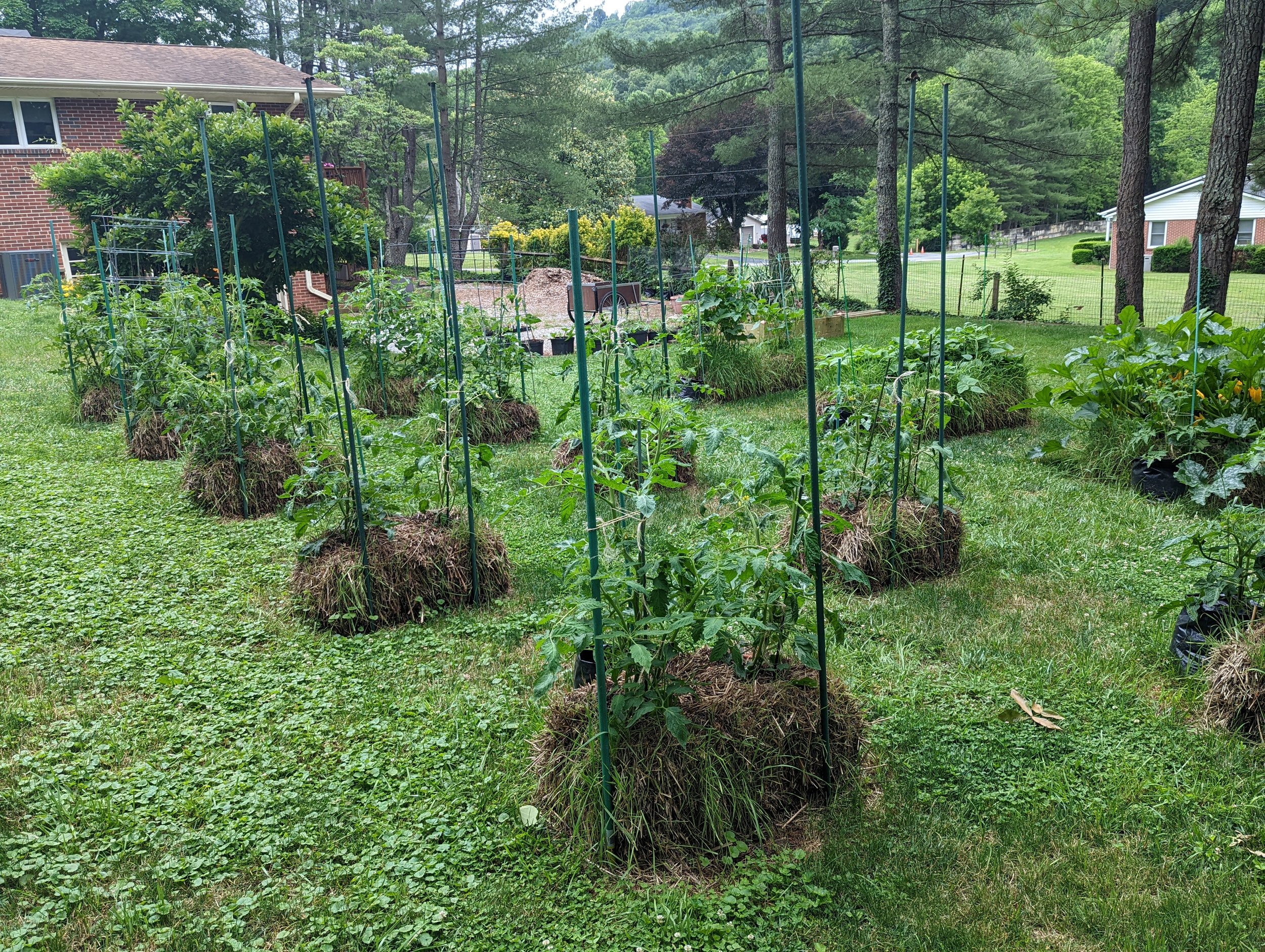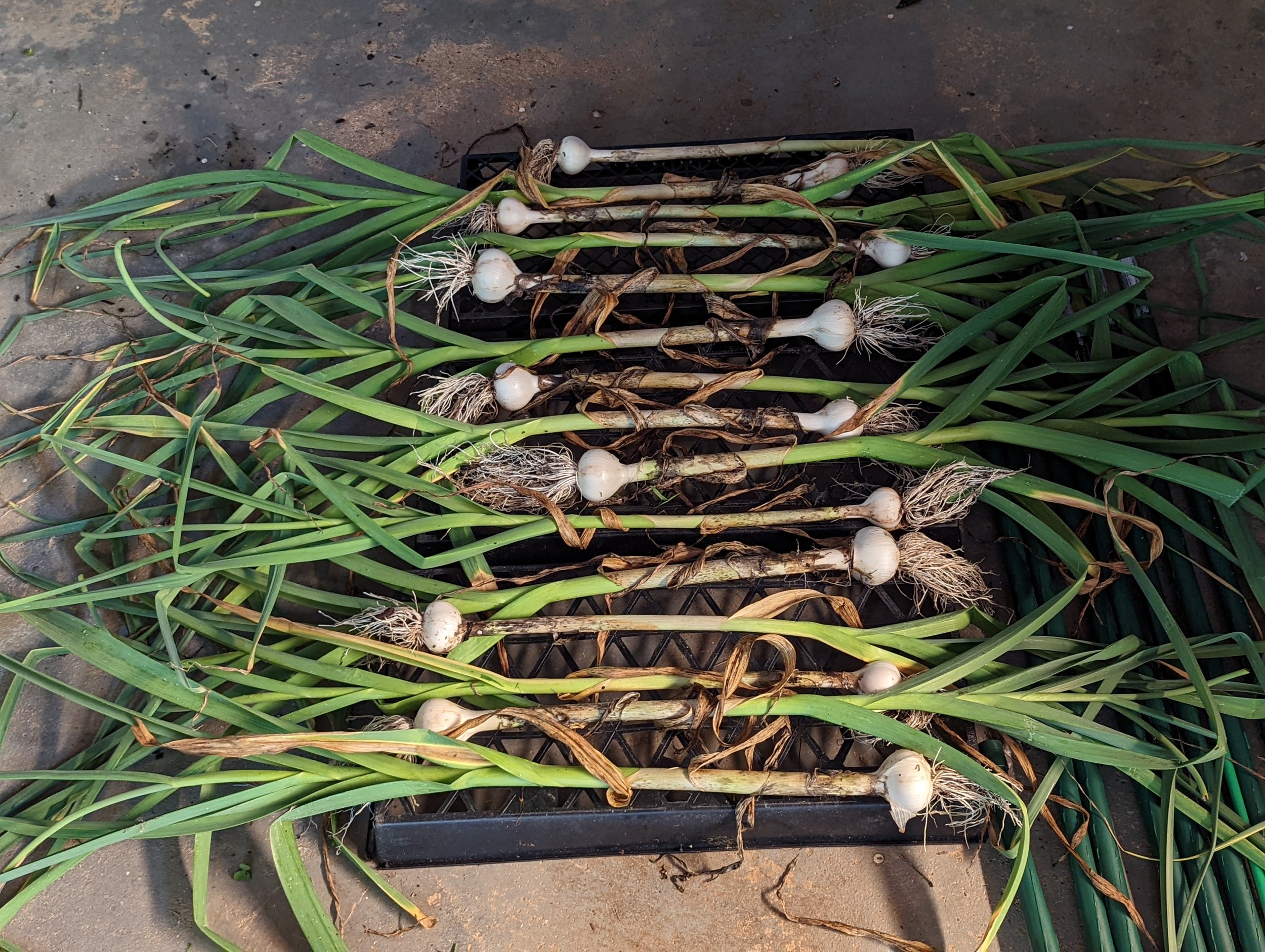June 22 view up a double column of tomato plants
It is hard to believe that this big report was only the 9th garden since my jump into focusing on heirlooms. Reading through it is very nostalgic - and clearly some tomatoes I loved need to be grown again soon!
_______________
The Mixed Bag of 1995
by Craig
It is hard to believe that it is already the first week of November. The summer went by like a blur, mostly due to the workplace challenge of surviving a merger. The garden was even more therapeutic than normal, and I was once again reminded of what a wonderful hobby it is. It was not the easiest growing season this year, due to a long dry start, followed by a solid month of rain just when foliage diseases get going. The second long dry spell that followed was a blessing, allowing me to salvage something out of what could have been a near total disaster! This article will summarize and describe the high- and low-lights of my 1995 garden. It was my most ambitious year with respect of number of tomato plants (120), and the high ratio of varieties that were obtained from the USDA collection. This garden gave me a few pleasant surprises, a good number of old favorites, yet a large number of failures as well; either plants that went down prematurely from disease, or quite a few varieties from which I harvested nothing at all! Ah, yes, the element of regional adaptation may have shown its face this year. Oh, well...enough chatter. On with the tour of the garden.
Among the USDA varieties, I was most impressed with Buckbee’s New Fifty Day, Golden Monarch, Cream City, New Big Dwarf, Yellow Ponderosa, Success, and The Orange. Buckbee’s New Fifty Day took a bit longer to mature than the name indicates, but gave me nice, smooth medium sized red fruit of delicious “old fashioned” flavor, which I suppose means it has a nice acid bite to balance its sweetness. It was released in the early 1900’s by Buckbee, which has now become Shumway. Another fine red tomato is Success, which was developed and released by the Maule Seed Company in 1900. Productivity and flavor are among its attributes. Two bright yellow tomatoes, Golden Monarch (from the 1930’s, as far as I can trace) and Yellow Ponderosa (possibly a Henderson variety from the turn of the century) are very similar, medium to nearly large, slightly oblate, but with a snappy, rich taste not frequently found in yellow tomatoes. Cream City, seemingly from Currie’s Seed Company in the 1930’s, and New Big Dwarf, from Isbell in 1915, are each sweet, delicious pink tomatoes. The notable thing about the latter is that it gives large fruit, nearly a pound, on a true dwarf plant that grows only about 2 feet tall. Supposedly, it originated from a cross between Ponderosa, a large pink indeterminate, with Dwarf Champion, a dwarf small fruited pink. Finally, The Orange, listed from Henderson in the 1930’s, is a large to huge, delicious, pale orange tomato that is remarkably similar to a more widely grown heirloom called Persimmon, whose background is unknown (perhaps they are one in the same).
Of the USDA obtained varieties that were not success stories were Albino (an ordinary red, of all things), Golden Glory (small bright yellow, kind of hollow inside, and bland), Abel, Earliest of All, Tops All, Trimson, Stick, High Crimson, Early Giant, Imperial, Victorian Dwarf #1, Ham Green Favorite, Mikado Ecarlate, Royal Wonder, Jagged Leaf, Dwarf Stone, Enormous, Giant Beauty, Heterosis, Bountiful (all varying sizes of red, some slightly better than others, but none standing above the rest), Nectarine, Peak of Perfection, Vivid, Potato Leaf Type, Dwarf Recessive, Mikado regular leaf, Giant Tree (all pinks of varying attributes), Orange King, Orange Chatham, Yellow, Gold Ball, Orange Tree, Golden Beauty (in the yellow to orange category, none outstanding), and, finally, those which met their demise from disease or no yield, including Matchless, Giant Italian Potato Leaf, Mikado potato leaf, Diener, and Santa Clara Canner. Despite my lack of enthusiasm for many of the above, most are significant commercial introductions of the early 1900’s, and should be maintained for historical and preservation reasons.
Finally, the true heirlooms remain to be discussed. Of the ones that were new to me this year, I was quite impressed with the following: Orange (orange, from Russia), Indische Fleische (dusky rose to purplish, large, delicious, from a SSE member), Azoychka (yellow, from Russia, wonderful), Big Yellow (huge deep yellow, from Dotty Noble, PA), Russian Persimmon (yellow, from Russia, superb), Orange Strawberry (from Carolyn, large orange heart, not a great yielder, though), A. C. Red (large potato leaf pink, also from Dotty), and Mennonite (large, oblate bicolor, sweet, from SSE member). Some did not impress me very much, including Lovelace Red (from a friend), Potato Leaf Hillbilly (from Carolyn), Bull Heart (pink, from Russia), Cosmonaut Volkov Red (large red, from Russia), and Southern Night (unusual determinate potato leaf dusky rose, from Russia, odd texture and flavor). I managed no fruit at all from the Russian variety Snowball.
Then there are the old favorites. Once again, I was delighted with the performance and flavor of Madara (yellow cherry tomato), Anna Russian (in my hall of fame!), Cherokee Purple (ditto), Eva Purple Ball, Livingston’s Favorite, Wins All, Livingston’s Beauty, Dorothy’s Green, Polish, Halladay’s Mortgage Lifter, Brandywine, Yellow Brandywine, Aunt Ruby’s German Green, Reif’s Red Heart, Nicky Crain, Livingston’s Magnus, Lillian’s Yellow Heirloom, and Stump of the World. It was, strangely, not a very good year for some other favorites, including Yellow White, Robinson’s German Bicolor, Big Sandy, Nina’s Heirloom, Hugh’s, Ukrainian Heart, Mullens’ Mortgage Lifter, Abraham Lincoln, Bisignano #2, Opalka, Potato Leaf Yellow, and Alpha Pink.
Last are the surprises that seem to occur each growing season. My Sun Gold cherry tomato hybrid growouts continued, resulting in a number of nice flavored, orange open pollinated cherry tomatoes. I also have a potato leaf red cherry tomato from this experiment. Then there are the potato leaf versions of Bisignano #2 and Madara, both resembling their parents. Finally, I had an interesting cross from Cherokee Purple seed. One of my plants gave me a dark brown, instead of pink, tomato. In other words, instead of green over red with a clear skin, it was green over red with yellow skin. The tomato was wonderful, and I will be growing out saved seed in hopes of stabilizing this unusual, unique tomato. If anyone wants to try out seeds from the above Sun Gold growouts, unexpected potato leaf varieties, or this Cherokee Purple cross, just let me know and I will send some seed.
That is all for now. It is time for me to get ready to send the seed descriptions that I will be offering in the 1996 yearbook to the SSE, then to prepare for the onslaught of seed requests. Until next newsletter, good-bye, and have a great winter holiday!
_____________________
This is a really interesting read for several reasons. The dark brown tomato from Cherokee Purple, which I assumed was a cross, ended up being a skin color mutation - Cherokee Chocolate was born! Azoychka finally emerged, a tomato I grew a few years ago in Raleigh and loved it. I also am reminded of how much I enjoyed Golden Monarch - it is definitely time to grow it again. A few other varieties that made a nice impression but somehow have become misplaced in my recent gardens are Buckbee’s New Fifty Day, The Orange, Success, Indische Fleisch, and Madara, just to name a few. Sadly, I will have to re-obtain seeds from SSE members, since my saved seeds are likely too old to germinate.
View of the 2022 garden on June 22 from the rear corner of the yard.





















